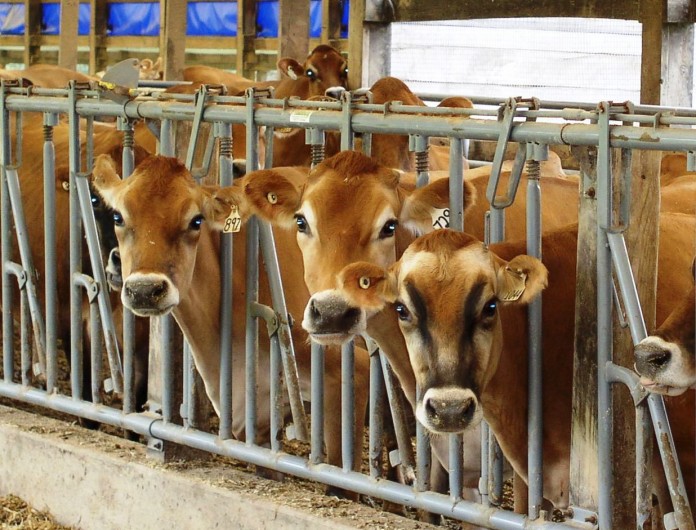Christmas is nearly here, the year is almost over, and 2014 will be remembered as one of the best year ever in the history of the dairy industry in the United States. However, its December ‘grand finale’ will be more like a thud!
November landscape
On Friday, Dec. 5, the USDA announced class and component prices for November. Class III price came out at $21.94/hundredweight, which historically is a very good price, but it was down $1.88/cwt from October.
Most of you are well aware that Class III milk is component priced in Federal Order 33, and those component prices (i.e., butterfat, protein and other solids) are calculated from national wholesale prices of cheddar cheese (bricks), butter, nonfat dry milk and dry whey. In November, the USDA used the following prices for its milk price calculations: cheese, $2.13; butter, $1.99; nonfat dry milk, $1.39, and dry whey, 64 cents.
Contrast these prices with spot prices at the closing on the Chicago Mercantile Exchange (CME) last Friday, Dec. 5: cheese blocks, $1.58 (down 15¢ in the last 2 weeks); butter, $1.98; nonfat dry milk, $1.11; and dry whey, 58 cents.
What this indicates is that milk prices are about to fall big time.
Shouldn’t be surprise
I have been writing about this incoming price crash since the middle of the summer. I am neither brilliant not a prophet of doom. There are just too many factors that make this price correction inevitable.
Increased production
Milk is flowing throughout most of the country, leading in substantial increases in dairy products output.
In October, production was up 1.5% for butter, 2.3% for cheese, and 17% for skim milk powder/nonfat dry milk compared to October 2013. Even more revealing, the output of nonfat dry milk itself was up a whopping 54 percent.
There is a lot of milk out there and a lot of cows, considering that the number of dairy cow slaughter is down 10.3% in 2014 vs. 2013.
Disappearing export markets
In the second half of 2013 and the first half of 2014, the U.S. was exporting dairy products at an unprecedented pace.
For example, during the last six months of 2013 and the first four months of 2014, the U.S. exported on an average of more than 10,000 metric tons of butter per month. That’s the equivalent of about 500 semi-trucks loaded with butter.
In October 2014, our butter exports had fallen to 2,000 metric tons per month.
Our butter is simply not priced competitively in the world market: Europe, $1.64/lb; Oceania, $1.40/lb; U.S., $1.98/lb.
At the Global Dairy Trade auction Dec. 2, cheddar sold for $1.36/lb, which was actually up 5.2% from the last auction. Cheddar cheese prices in the $1.35 to $1.40/lb translate to a $14/cwt Class III milk.
Outlook for 2015
I anticipate milk prices to drop by about $4/cwt in December, with a Class III price closing in the low $18/cwt.
As of this writing, the CME December Class III futures are trading at $17.75/cwt. For all of 2015, Class III futures are currently averaging $16.51/cwt, which would put the average mailbox price in Federal Order 33 at about $18/cwt for the year.
Traders are expecting a low of $15.82/cwt in February. I think that this is still overly optimistic as I see Class III prices bottoming in the $14-$15 range during spring.
On the expenses side of the ledger, it appears the bottom for feed prices was reached in early October.
Those who were forecasting corn prices below $3/bushel when corn was trading at $3.50/bu. were looking at the wrong end of the telescope. It now appears that $4/bu. will be more in line with corn prices in 2015.
Mind you, $4/bushel is most definitely better than the $8/bushel we had a couple years ago, but it isn’t cheap — not when your milk is paid $16/cwt.
Take action
You don’t have to wait until the crisis hits you. We all become a little complacent in our management when our operation is bringing in strong returns, as was the case in 2014.
Between now and the first of the year, sit down and write down a budget for 2015. During the first week of January, conduct a full inventory on your farm (number of cattle in each age group, feed and equipment inventory, etc.), so that you and/or your financial adviser can produce an accurate balance sheet.
Pay special attention to your cash flow projections. Re-evaluate all expenses, big and small.
And above everything else, make sure that you enjoy the holiday season with your loved ones: You deserve it!














Mr.St.Pierre. Believe you are exactly correct.It seems to me that the “hand writing is on the wall” this ship is beginning to list !?Seems like the time to cull extra cows!? The encentive is there (never seen hamburger cows this high before either) wish Hoards and other dairy publications would run full page large print ads “We’ve got to get ride of our surplus,SELL COWS. Thanks for listening.David Handley
P.S. If you are acquainted with David Zartman say hello for me
Mr. Handley,
Thank you for your comment. Your point about culling some cows is probably a wise one especially, as you point out, if one considers the very strong prices paid for cattle.
I know Dr. Zartman very well; he was Chairman of my department at Ohio State when I came back to Ohio. Dr. Zartman retired a few years ago and he is doing fine (as far as I know). I will transmit your salutations next time I see him.
Thank you, Mr. St-Pierre; great analysis and good read.
Looks like major portions of the commodity markets are on the downswing.
In addition to dairy products, look at oil and even precious metals–all DOWN substantially.
Why such a stark contrast in our butter price vs. the rest of the world? Why is ours so much higher?
It is very important to cull dairy cows now. As the article, and some of the comments stated, the hand writing is on the wall, however, some dairy producers are not “reading” the writing. Most of the dairy producers that I know, have increased production and there has been a lot of new dairy start ups, especially among the Amish. As one producer told me, qoute “we are milking more cows than ever before because of the pay price. I would buy more cows increased they weren’t so expensive”……..What happens when our nation’s dairy farms produce more milk than what can be utilized?